Negotiating Relationships and Redefining Traditions: Syrian and Iraqi Women Refugees in Jordan
#narrativesofdisplacement
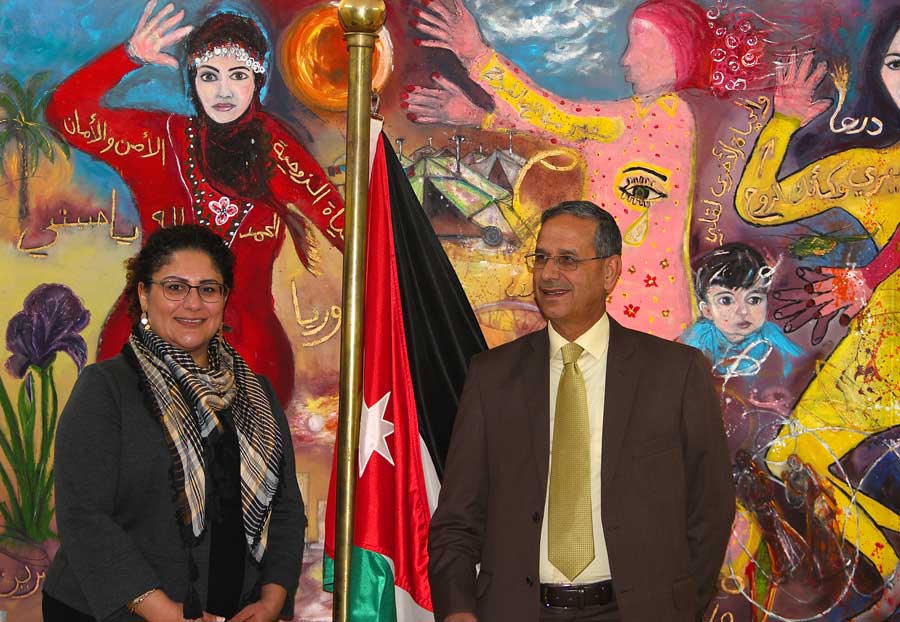 Narratives of displacement is a research-based project of the University of Birmingham and funded by the British Academy, documenting the effects of the long and extensive conflict in Syria and the consequent process of significant temporary and permanent displacement of families, upon the marriages and the family-units of the many thousands of Syrian and Iraqi women affected, and now living as refugees, and as asylum-seekers, within several host nations, namely: Germany, UK and Jordan.
Narratives of displacement is a research-based project of the University of Birmingham and funded by the British Academy, documenting the effects of the long and extensive conflict in Syria and the consequent process of significant temporary and permanent displacement of families, upon the marriages and the family-units of the many thousands of Syrian and Iraqi women affected, and now living as refugees, and as asylum-seekers, within several host nations, namely: Germany, UK and Jordan.
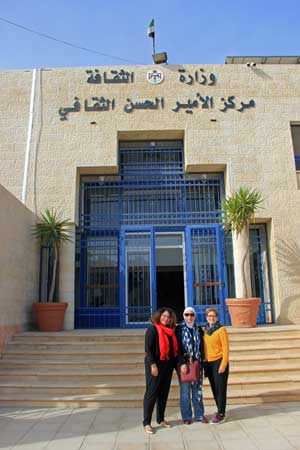 The project is devised and directed by Dr Yafa Shanneik, and comprises at its core the collecting and collating of data, in several locations, in this instance within Jordan, by Shanneik, by means of a comprehensive and broad-reaching programme of interviews with women affected, personal testimony, that considers the sustainment of the marriage and the family unit, and those topics directly related to this, ranging from, the physical, and frequently arduous and perilous, journey from home to host country, to the shifting balance as to the family provider – affected in turn by, for example, skills and the availability of opportunity, psychological changes within individual family members, cultural differences within those host nations.
The project is devised and directed by Dr Yafa Shanneik, and comprises at its core the collecting and collating of data, in several locations, in this instance within Jordan, by Shanneik, by means of a comprehensive and broad-reaching programme of interviews with women affected, personal testimony, that considers the sustainment of the marriage and the family unit, and those topics directly related to this, ranging from, the physical, and frequently arduous and perilous, journey from home to host country, to the shifting balance as to the family provider – affected in turn by, for example, skills and the availability of opportunity, psychological changes within individual family members, cultural differences within those host nations.
Dr Shanneik is acutely conscious of the forced upheaval, the diaspora of no choosing, and the desire therefore, the longing, of those affected, to give voice to the emotional impact, simply to tell their own stories. And, for this reason she has enlisted the services of artist Dr Rachel Gadsden, who will, over an extended period, work with the interviewees, together with family members, mothers, sisters, children, to create mural-style artwork, using the body-mapping process as a starting-point, to depict not only the destruction they may have left behind, the harrowing passages and the significant demands imposed by the process of integration, but also, perhaps, the opportunities, both foreseen and unforeseen, of the new circumstances that they find themselves in.
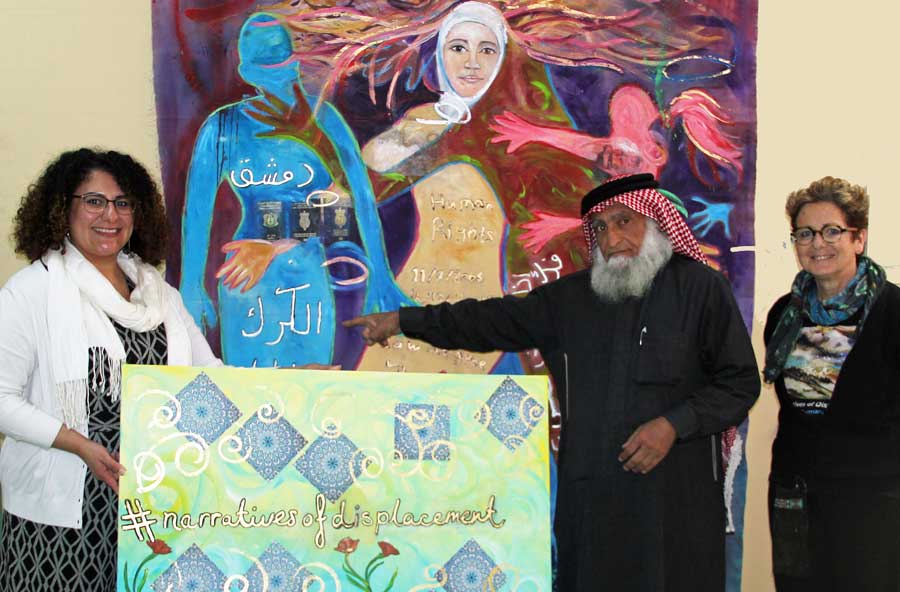 The artwork will serve an additional purpose: the opportunity for the testimony, the stories, to be presented to the outside world, a public voice in the form of an exhibition; and therefore, as a means of enhancing this experience, composer and musician Freddie Meyers has been commissioned to compose an original score integrates the Syrian and Iraqi narratives as part of a live art performance, that will sit alongside the exhibition of artworks, to provide an additional layer in terms of expressing the emotional response.
The artwork will serve an additional purpose: the opportunity for the testimony, the stories, to be presented to the outside world, a public voice in the form of an exhibition; and therefore, as a means of enhancing this experience, composer and musician Freddie Meyers has been commissioned to compose an original score integrates the Syrian and Iraqi narratives as part of a live art performance, that will sit alongside the exhibition of artworks, to provide an additional layer in terms of expressing the emotional response.
The starting-point for this particular leg of the project is the one-time fortified town of Karak. Historically, Karak was always of importance, in its strategic location overlooking the easy trading route formed by the valley and the escarpment that is now the Kings Highway, running from north to south through the centre of the country. There will always have been a ‘stop-over’ here, and certainly in the time of the Nabateans, it would have been both a military base and one of many toll-gates, alongside of course Petra in the south, used to control the movement of frankincense, in particular, shipped and sold to Rome, that made the Nabateans so wealthy and enduring. Later, it was held by the Romans themselves, and later again the Frankish Crusaders, who used it as a means of protecting Jerusalem, until finally it was laid siege to and liberated by Saladin.
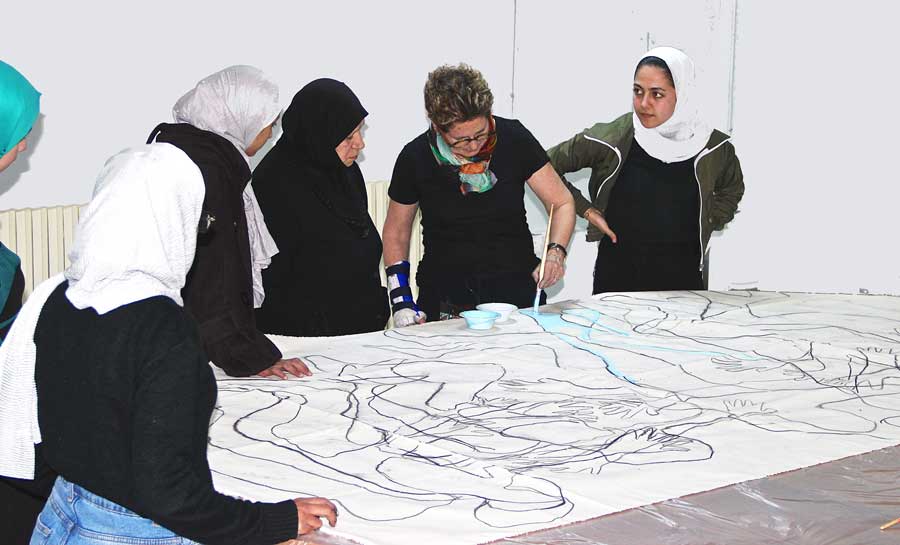
This fascinating and colourful history is of great significance in terms of Narratives of Displacement, exemplifying as it does the history of the different forms of migration, movement, cross-cultural trade and interface that has been instrumental in forging the tolerant and diverse nature of modern Jordan.
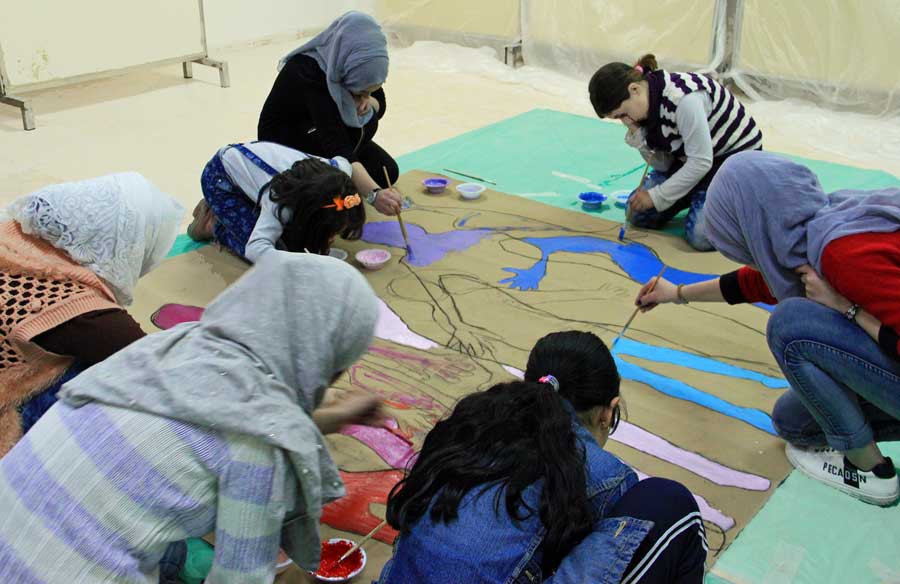 Since the conflict in Syria began it is understood that there are, conservatively, over a million Syrians currently taking refuge in Jordan, and the country therefore actively engages in seeking to understand the many and continuing pressures consequent to this, borne not only by the refugees themselves but by their hosts, and impinging upon the infrastructure and social and work environment, the better to accommodate the enormous influx.
Since the conflict in Syria began it is understood that there are, conservatively, over a million Syrians currently taking refuge in Jordan, and the country therefore actively engages in seeking to understand the many and continuing pressures consequent to this, borne not only by the refugees themselves but by their hosts, and impinging upon the infrastructure and social and work environment, the better to accommodate the enormous influx.
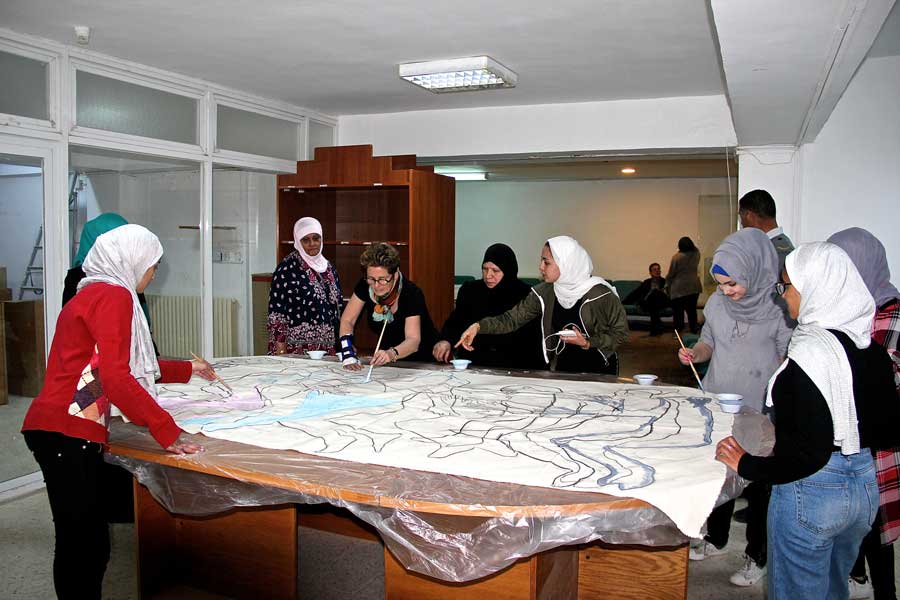 The project for five days has based itself at the Al Hassan Cultural Community centre, interestingly on the other side of the valley from, and having spectacular views of, the liberated fortress. Strategically this location is still of importance. Under the inspirational guidance of its director, Ouruba al Shamayle, the community centre houses an extensive library, research and study rooms, and also a brilliant 800 seat theatre and, used in conjunction with Karak University, attracts students hailing from every other part of the country, north and south.
The project for five days has based itself at the Al Hassan Cultural Community centre, interestingly on the other side of the valley from, and having spectacular views of, the liberated fortress. Strategically this location is still of importance. Under the inspirational guidance of its director, Ouruba al Shamayle, the community centre houses an extensive library, research and study rooms, and also a brilliant 800 seat theatre and, used in conjunction with Karak University, attracts students hailing from every other part of the country, north and south.
The immediate vicinity of the centre alone plays host to many hundreds of refugee families, and so over the juration of our stay the centre has witnessed a continuous visitation of the women and their families, attending for interview with Shanneik, and subsequently to interact in creating body-mapping paintings. The interviewing process has been successful and revealing in documenting individual narratives, and the participants have rendered their often-harrowing stories within a total so far of 7 narrative canvases.
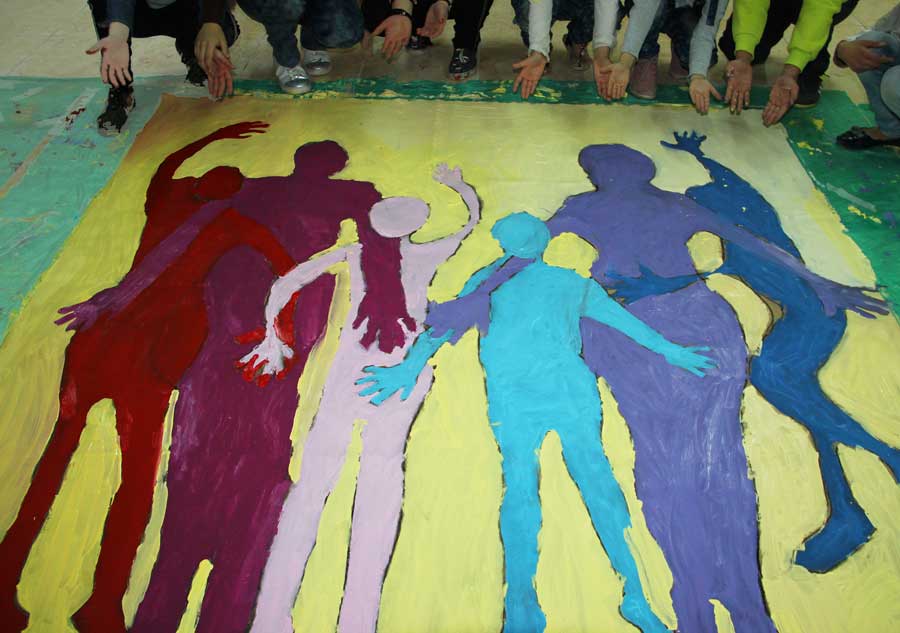
The venue has proved wholly appropriate for additional reasons. The centre plays host to the regular round-table forum of local community leaders, and consequently on Wednesday, Shanneik was given the opportunity to present to a near full complement of forum members including influential local tribal and community leaders. The talk generated considerable interest and discussion amongst the forum, who voiced their appreciation of the objectives, and offered continuing support.
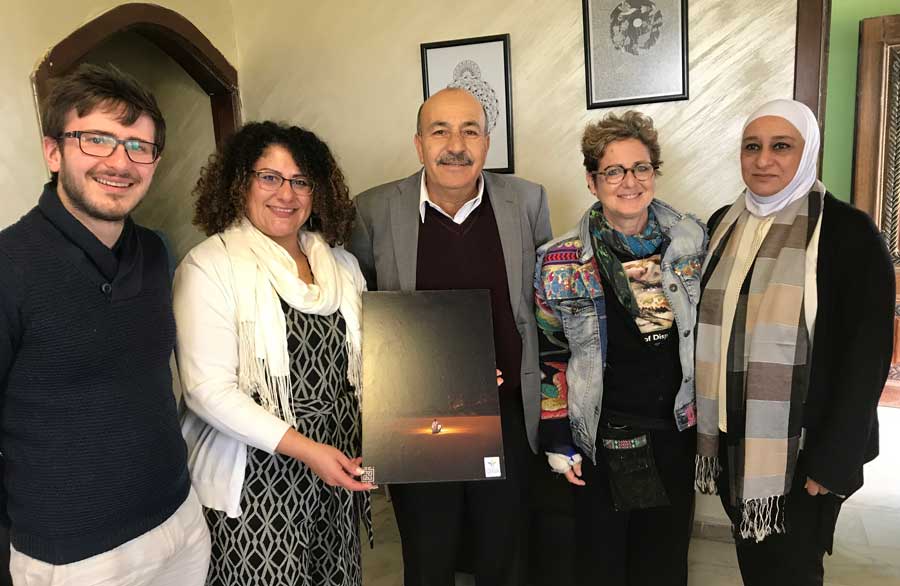 Subsequently the governor of Karak, Dr. Jamal Al Fayez, visited the centre to familiarize himself with the research, taking a short break for coffee and relaxed discussion about the project’s aims and objectives, and additionally contributing to the artwork underway, completing a part of the painted surface of one of the artworks, and also superimposing in charcoal some of the written word to be contained in the finished pieces.
Subsequently the governor of Karak, Dr. Jamal Al Fayez, visited the centre to familiarize himself with the research, taking a short break for coffee and relaxed discussion about the project’s aims and objectives, and additionally contributing to the artwork underway, completing a part of the painted surface of one of the artworks, and also superimposing in charcoal some of the written word to be contained in the finished pieces.
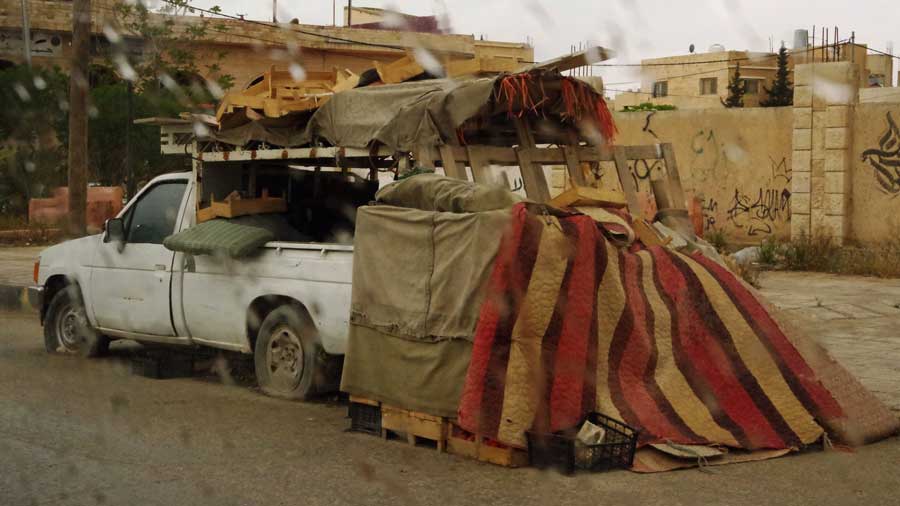
From Karak we journeyed north to Irbid where the weather took a turn for the worse. With the rain and the cold, we were conscious of how such conditions might affect our ability to link up with prospective artistic collaborators. The first workshop in Irbid brought together a group of both Syrian and Iraqi women and was hosted in a private home. A red plastic swing swaying in the sitting room, caught our attention. Our Iraqi host has 2 young children, a daughter, and a son who is autistic. The swing allows the son to continue to enjoy physical activity throughout the winter months – this winter, apparently, having been one of the longest. We painted two canvases; one that accommodated two Syrian sisters and our Iraqi host, and one created on traditional dark canvas and telling the stories of displacement of the four Iraqi women, designed in a circular pattern and evoking journeys and life’s force. After the women drew and painted, music filled the air as all the Iraqi women danced and sang traditional songs together. It was a joy for Yafa and Rachel to witness: art and music transports the mood, and the women let their feelings go, laughed, sang and danced together. Rachel recorded their ululation; to incorporate in the music and performance Freddie Meyers is composing.
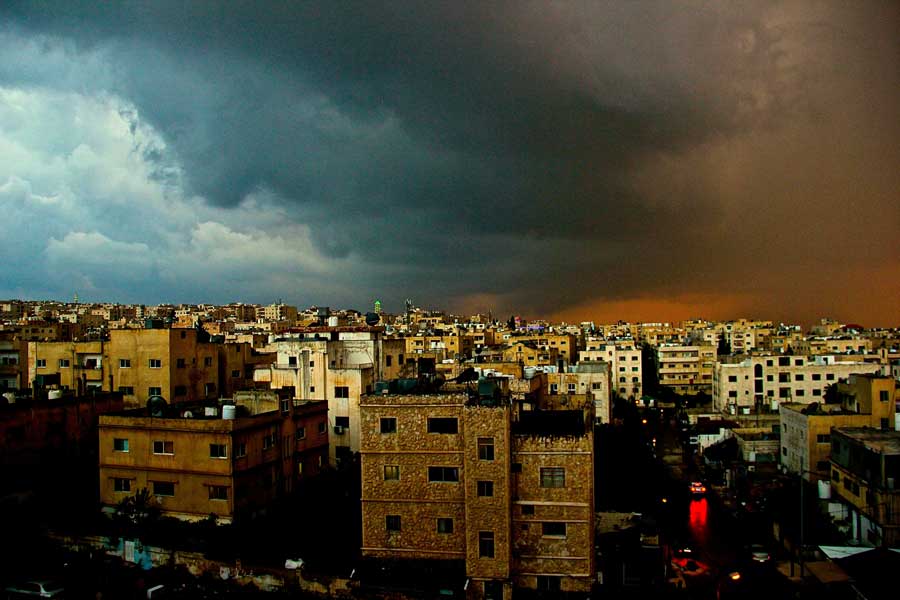
That night there was crashing thunder and flashes of lightning, so no surprise that our trip to Mafraq, further north, had to be postponed – flooding can be a hazard on these occasions as rainwater pours down from the mountains and fills up the dry wadis. So instead the project headed to a Palestinian refugee camp, to a society that supports orphaned children.
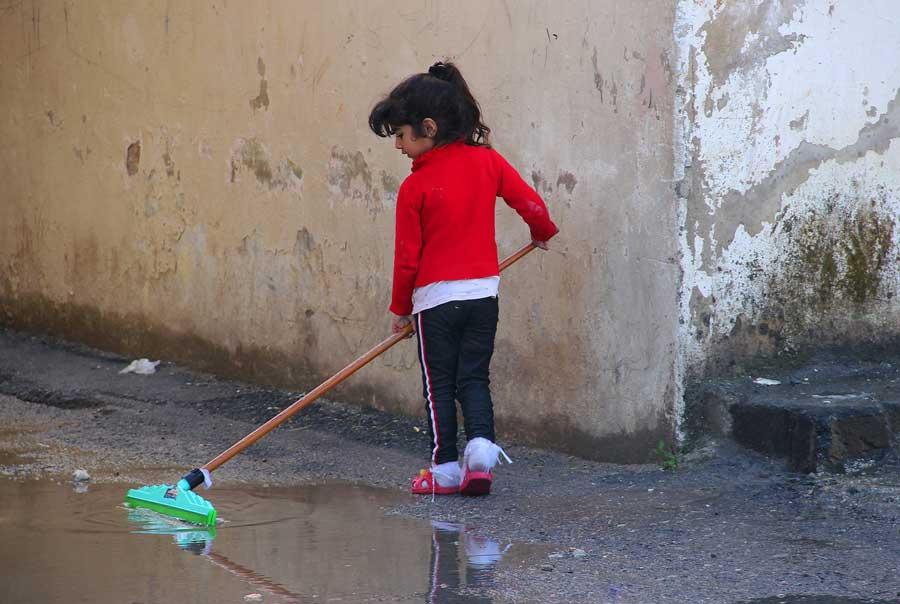
Freddie and Tim were not able to join the workshop and so went off to film the surrounding area. Hearing the stories of migration is always a challenge, but as Yafa interviews the women a clear narrative emerges to guide the piecing together of the artwork. This time there were two Iraqi women and also two Syrian women. Despite living in the same building, the two Syrians had never before spoken to one another. One of the Iraqi women has been fantastically creative in her efforts to secure the lives of her children, taking whatever work she can to support her family, having been widowed five years ago. Adoption is rare in these communities so it was heartening to hear about the work of the society as it goes about raising funds to educate and support the young orphans. The psychological impact upon the women is invariably, but perhaps not always addressed or discussed, and the process of art and the interviews can be cathartic, allowing the women to be open and perhaps emotionally truthful about their predicament.
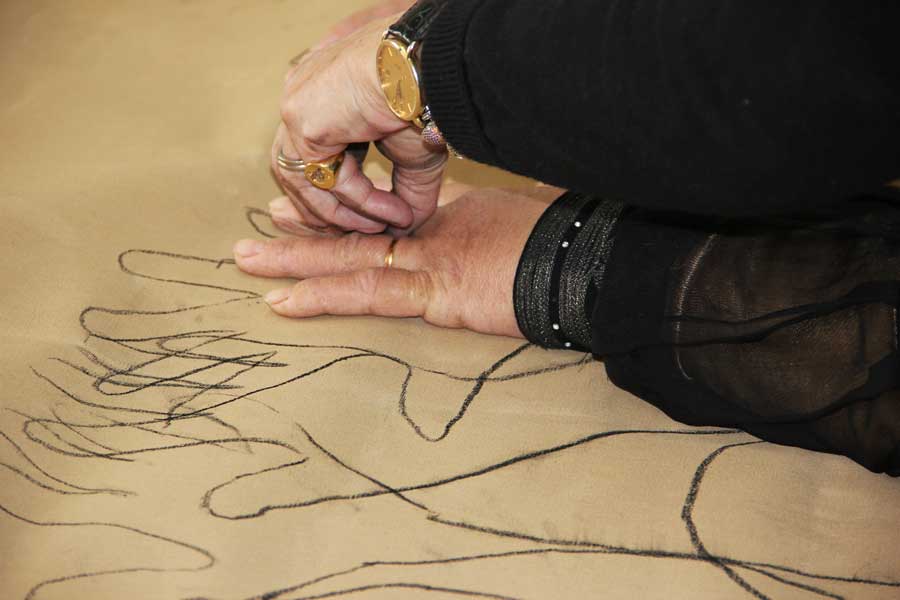 The weather turned the following day, so Mafraq was back on the schedule. The project visited a centre that teaches basic skills to support and enable refugees to seek work. A group of five women who all had direct contact with the centre joined the workshop. The women were all from Homs, and its environs. One of the canvases tells of the many ways the refugees fled their homeland and made their way to Jordan, both north and south. The key factor that emerged was that all of the women wanted to hold hands in the painting. It is clear that they support one another. Yafa and Rachel had the opportunity to visit the temporary homes of three of the women. As is to be expected, living conditions can sometimes be difficult, with problems related to dampness, for example, lack of adequate heating, and overcrowding. Despite the challenges the women were making traditional food to sell in the market and doing whatever they could to make the daily conditions and circumstances for their families better.
The weather turned the following day, so Mafraq was back on the schedule. The project visited a centre that teaches basic skills to support and enable refugees to seek work. A group of five women who all had direct contact with the centre joined the workshop. The women were all from Homs, and its environs. One of the canvases tells of the many ways the refugees fled their homeland and made their way to Jordan, both north and south. The key factor that emerged was that all of the women wanted to hold hands in the painting. It is clear that they support one another. Yafa and Rachel had the opportunity to visit the temporary homes of three of the women. As is to be expected, living conditions can sometimes be difficult, with problems related to dampness, for example, lack of adequate heating, and overcrowding. Despite the challenges the women were making traditional food to sell in the market and doing whatever they could to make the daily conditions and circumstances for their families better.
The final destination for the project was Amman, where the project was hosted at the Baqa’a Palestinian refugee camp. It was market day in Baqa’a, so our journey into the camp was more a case of maneuvering around stallholders than following the road. Al Baqa'a camp was one of six "emergency" camps set up in 1968 to accommodate Palestine refugees and displaced people who left the West Bank and Gaza Strip as a result of the 1967 Arab-Israeli war. Over 200,000 people live in the camp now; the community has welcomed recently many Syrian and Iraqi refugees.
We were hosted by an organisation that also supports orphans, and they had brought together the group of Syrian women refugees and their children for our art workshop. Their husbands and fathers are all missing as a direct result of the Syrian conflict. We hear this narrative often, the bravery of each of the women as they share their stories and continue to support their families in the best possible way they can, is humbling. We will be creating a full narrative artwork, but these images say so much already.
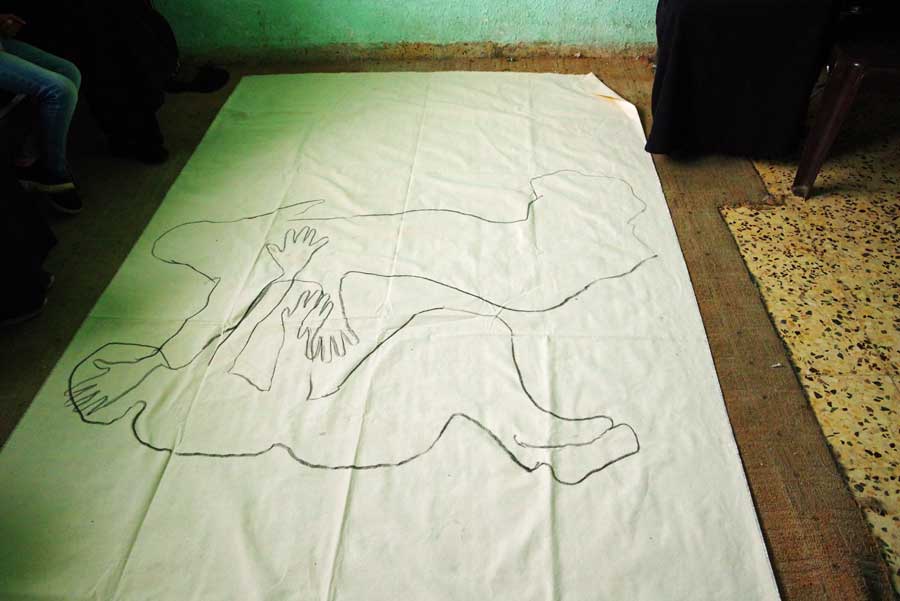
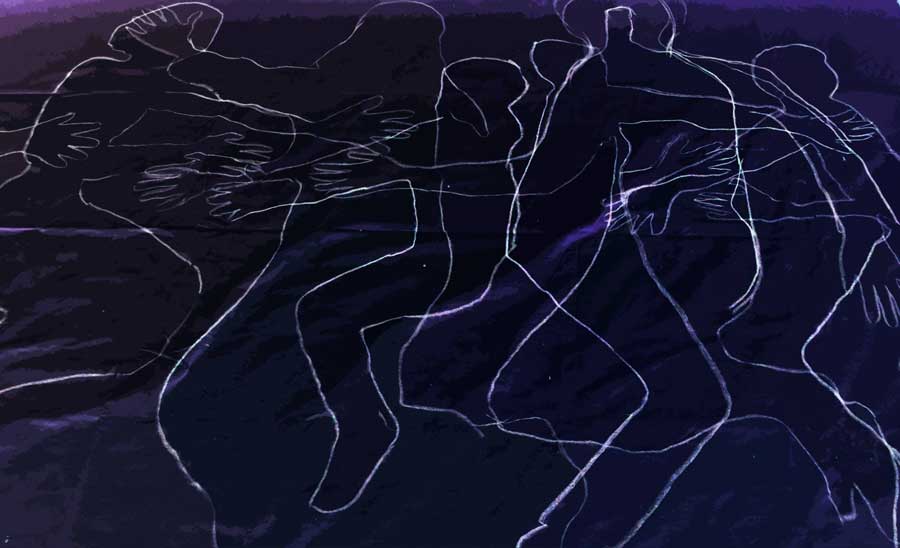 We were additional joined in this workshop by Nicola Hope and Laura Hope, friends of Rachel’s. Nicola is at University studying Arabic and is currently attending Arabic classes as part of her degree process in Amman, and Laura, an Italian literature teacher was visiting her daughter. Additionally so as not to let the men miss out of the experience of the centre and the Baqa’a hospitality, the hosts took all of us on a tour of the camp after the workshop.
We were additional joined in this workshop by Nicola Hope and Laura Hope, friends of Rachel’s. Nicola is at University studying Arabic and is currently attending Arabic classes as part of her degree process in Amman, and Laura, an Italian literature teacher was visiting her daughter. Additionally so as not to let the men miss out of the experience of the centre and the Baqa’a hospitality, the hosts took all of us on a tour of the camp after the workshop.
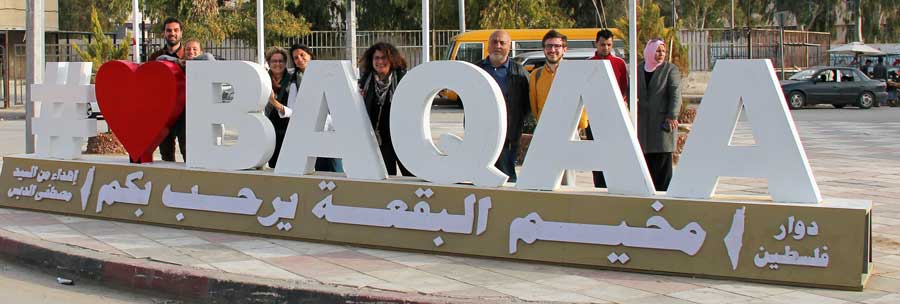 Having listened to many harrowing and challenging stories of displacement during their time in Jordan, told by the Syrian and Iraqi refugee artistic collaborators, at the forefront of Yafa’s and Rachel’s mind is the fact that displacement is never a temporary predicament, it is a continuing one. The emotional scars are life long, and they have yet to meet a single refugee whose greatest hope is anything other than to safely return home.
Having listened to many harrowing and challenging stories of displacement during their time in Jordan, told by the Syrian and Iraqi refugee artistic collaborators, at the forefront of Yafa’s and Rachel’s mind is the fact that displacement is never a temporary predicament, it is a continuing one. The emotional scars are life long, and they have yet to meet a single refugee whose greatest hope is anything other than to safely return home.
This was even more evident at Baqa'a Refugee Camp. Vulnerable individuals have a remarkable ability to survive, and ultimately they have no other choice other than to do just that.